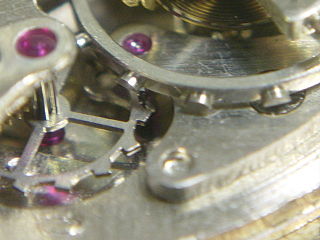
Genus is a taxonomic rank above species and below family as used in the biological classification of living and fossil organisms as well as viruses. In binomial nomenclature, the genus name forms the first part of the binomial species name for each species within the genus.

A Roskopf, pin-lever, or pin-pallet escapement is an inexpensive, less accurate version of the lever escapement, used in mechanical alarm clocks, kitchen timers, mantel clocks and, until the 1970s, cheap watches now known as pin lever watches. It was popularized by German watchmaker Georges Frederic Roskopf in its "proletarian watch" from 1867. It was invented in 1798 by Louis Perron, of Besançon, and suggested to Roskopf by Jules Grossmann.
Cell migration is a central process in the development and maintenance of multicellular organisms. Tissue formation during embryonic development, wound healing and immune responses all require the orchestrated movement of cells in particular directions to specific locations. Cells often migrate in response to specific external signals, including chemical signals and mechanical signals. Errors during this process have serious consequences, including intellectual disability, vascular disease, tumor formation and metastasis. An understanding of the mechanism by which cells migrate may lead to the development of novel therapeutic strategies for controlling, for example, invasive tumour cells.
Mark Steven Bretscher is a British biological scientist and Fellow of the Royal Society. He worked at the Medical Research Council Laboratory of Molecular Biology in Cambridge, United Kingdom and is currently retired.

Egon Bretscher was a Swiss-born British chemist and nuclear physicist and Head of the Nuclear Physics Division from 1948 to 1966 at the Atomic Energy Research Establishment, also known as Harwell Laboratory, in Harwell, United Kingdom. He was one of the pioneers in nuclear fission research and one of the first to foresee that plutonium could be used as an energy source. His work on nuclear physics led to his involvement in the British atomic bomb research project Tube Alloys and his membership of the British Mission to the Manhattan Project at Los Alamos, where he worked in Enrico Fermi's Advanced Development Division in the F-3 Super Experimentation group. His contributions up to 1945 are discussed by Margaret Gowing in her "Britain and Atomic Energy, 1935-1945."
Anthony P. Bretscher is a professor of cell biology at Cornell University in the Department of Molecular Biology & Genetics in the College of Arts and Sciences.
Mesobuthus is an Asian genus of scorpions in the family Buthidae.

The Interim Register of Marine and Nonmarine Genera (IRMNG) is a taxonomic database which attempts to cover published genus names for all domains of life, from 1758 in zoology up to the present, arranged in a single, internally consistent taxonomic hierarchy, for the benefit of Biodiversity Informatics initiatives plus general users of biodiversity (taxonomic) information. In addition to containing just over 500,000 published genus name instances as at May 2023, the database holds over 1.7 million species names, although this component of the data is not maintained in as current or complete state as the genus-level holdings. IRMNG can be queried online for access to the latest version of the dataset and is also made available as periodic snapshots or data dumps for import/upload into other systems as desired. The database was commenced in 2006 at the then CSIRO Division of Marine and Atmospheric Research in Australia and, since 2016, has been hosted at the Flanders Marine Institute (VLIZ) in Belgium.
Exsul is a genus of flies belonging to the family Muscidae.
Trieres is a genus of beetles belonging to the family Elateridae.

Forda is a genus of aphids belonging to the family Aphididae. The genus was first described by Carl von Heyden in 1837. The species of this genus are found in Eurasia and North America.
Homochaeta is a genus of annelids belonging to the family Naididae.
Aulodrilus is a genus of annelids belonging to the family Naididae.

Naineris is a genus of polychaete annelids belonging to the family Orbiniidae. It was first described by Henri Marie Ducrotay de Blainville in 1828. The type species is Nais quadricuspida Fabricius, 1780, currently accepted as Naineris quadricuspida. The genus has cosmopolitan distribution.
Odontionopa is a genus of leaf beetles in the subfamily Eumolpinae. It is distributed in Africa.
Actinodendron is a genus of cnidarians belonging to the family Actinodendridae.
Gastroblastea is a genus of cnidarians belonging to the family Campanulariidae.
Phialucium is a genus of cnidarians belonging to the monotypic family Phialuciidae.

Babesiidae is a family of protists belonging to the order Piroplasmida.
Lestonia is a genus of true bugs belonging to the monotypic family Lestoniidae.






